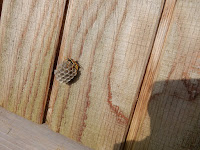When you have an horticultural bent and one slim acre with which to play, you may be inclined to try a little of this, some of that. I like to think of our place as "the Valley Sampler," and in keeping with that moniker I've added gooseberries to the backyard garden.
Just how the cultivar came to be called the "gooseberry" I have yet to discover. In fact, one plus of the gooseberry is, unlike our other berry crops, birds avoid it; the bushes require no protective netting. When I tell them I grow the fruit, most people ask for an explanation; not only have they never seen a gooseberry but mere mention of the plant is usually a first for them.
The gooseberry is native to Europe (Ribes uva-crispa) and put to a variety of uses there, primarily in preserves, jams, jellies, and conserves. I cultivate two bushes: the Old World variety and the North American strain Ribes hirtellium. The former fruits a green berry that ripens to a yellowish color; the latter, a larger fruit, purple when ripe.
I was excited for my first crop, anxious to make a batch of jelly. Although the fruit is uncommon here in the U.S., I had no trouble finding a jelly recipe. In fact I found recipes for jam, preserves, conserves, and something the English call a "gooseberry fool," a dessert concoction of stewed gooseberries in sweet custard. All recipes gave precise proportions of sugar and juice, cooking times, processing and storage guidelines, which was all well and good...but not a one told you WHEN THE GOOSEBERRIES WERE RIPE. I picked the berries at the "pucker" stage of ripeness, the point at which my grandson, whose four-year old palate craves sour things, screwed his face into a Shar Pei's likeness when he crunched down on the green orb.
The jelly turned out so-so...certainly sweet enough (after all, jams and jellies are nothing more than fruit flavored sugar) but had very little flavor.
Then came the pie fiasco. And you know how that turned out. More research needed: how to tell when a gooseberry is ripe. This is what I learned--post pie disaster unfortunately. First, there's the "squeeze" test. Take a berry between the thumb and index finger and squeeze, If the result is like pinching a marble, save the berry for my grandson; however, if the fruit "gives," is sponge-like, it's pie-ready. The pie maker can double check by the "taste" test. The berry should have a sweet-sour quality: the flesh sweet; the skin tart.
After climbing to those heights on the gooseberry learning curve, I attempted pie number two, a recipe I found for "Old-Fashioned Gooseberry Pie," the ingredients of which complement the unique flavor of the fruit. The ingredients follow:
5 cups gooseberries, blossom ends and stems removed
1 1/2 cups sugar
2 Tbsp grated fresh ginger
Juice and zest of one orange
1/3 cup instant tapioca
4 Tbsp butter (set aside for later)
Combine all ingredients except butter in a large sauce pan and place over medium heat. Cover until gooseberries start to soften and burst (about 5 minutes). Then uncover and keep barely simmering on medium-low heat for about ten minutes. Remove from heat and cool.
The crust: one Man Crust (top and bottom). Form bottom crust in a nine inch pie plate, fluting the rim of crust. Weight with pie weights and bake at 375 degrees for ten minutes or until golden brown. Ladle in filling, spread butter in dollops evenly throughout the filling.
Top crust: using the rim of a small glass or cookie cutter, fashion circles from the pastry and layer them in a concentric circle pattern, leaving a hole in the middle and an inch to an inch and a half space between rim and outer ring of pastry. Whisk together one egg and a Tbsp of milk and brush the pastry circles with the egg wash.
Bake at 375 degrees for 35-50 minutes until vigorously bubbling. (Suggestion: set pie on a metal sheet or pizza pan; filling will bubble over.)
Approximate time to prepare: 2 1/2 to 3 hours. Note: Much longer if you have to pick the gooseberries. Longer yet if you have to grow them. Good luck.
Attribution: beekman1802.com/recipes/old-fashioned-gooseberry-pie











